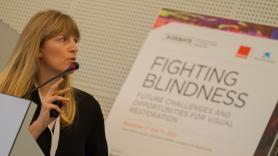2. Optogenetics, electricity and nanotechnology to fight blindness
The most novel forms of treatment for blindness can be broken down into two categories. As explained Eduardo Fernández, professor at Miguel Hernández University of Elche, who distinguishes between “biological and technological forms.”
One of the most promising in the first category is called optogenetics and has already begun testing in clinical trials. Studies have started in patients with pigmentary retinitis, an illness that destroys retina cells that capture the light. Optogenetics aims to implant genes from algae into cells that couldn't capture light, allowing them to do so. This way, ganglion or bipolar cells, which only transmit electrical pulses and are normally spared in many cases of retinal degeneration, become light receptors and take over for the destroyed photoreceptor cells. As Jordi Monés explained, it means a cell “becomes not just a cable but a receptor."
“Through optogenetics, a cell could become not just a cable but a receptor”
The therapy, applied in blind patients, does not allow them to recover normal color sight, but doctors do hope they will be able to recognize shapes, read large letters and get around. Meanwhile, as was explained by Marco Zarbin, professor at the Institute of Ophthalmology in New Jersey, scientists are working on new, more sophisticated optogenetic methods to improve results.
The other forms are, to a certain extent, purely technological, using electronic chips. “Vision is based on electric impulses, like an electronic circuit,” says Eduardo Fernández. So, scientists are trying to copy their signals with visual prostheses. They normally have a camera to capture images, a processor to encode them and an electronic circuit board to stimulate the nervous cells, either in the retina or the brain, in the occipital areas responsible for sight. Although some devices have gained approval, it isn’t an easy path: “It’s very difficult to reproduce the patterns of the retina: shapes, colors, contexts, etc.” says Fernández.
One reason for optimism, however, is the fact that the brain is extremely flexible. This was proven in what is considered the first cyborg in the world: Neil Harbisson. This man, who can’t distinguish between colors, has an antenna implanted in his body that transforms them into sounds, allowing him to recognize them using the areas of the brain that control hearing. A study of his brain images revealed the unusual network of connections running to and from this area, which was considerably denser than in a normal brain.
Another important area is nanotechnology, a technological tool that promises to be a vehicle for new biological therapies. According to Víctor Franco Puntes, ICREA professor at the Catalan Institute for Nanoscience and Nanotechnology, nanoparticles offer a wide variety of advantages, including “the fact that they can interact with biology, transport and administer drugs, and even maybe direct implanted cells.” One of the possible applications for blindness lies in using particles that act as antioxidants, but above all it lies in those that can act as a vehicle and facilitate one of the greatest promises in new medicine, along with stem-cell transplants: gene therapy.
“Nanoparticles can interact with biology, transport and administer drugs, and even maybe direct implanted cells”



